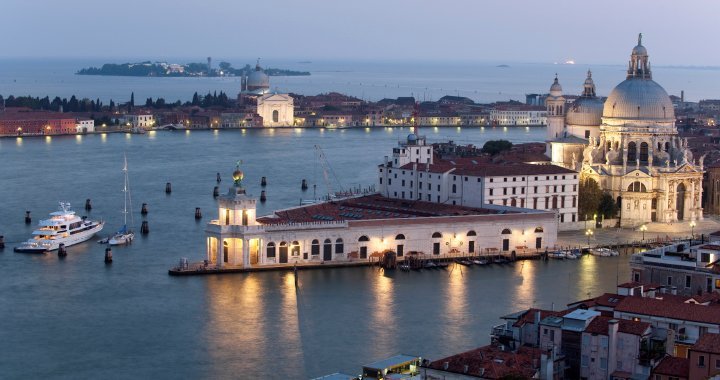
The “Parallel Biennale”
A Guide to the Satellite Events of the 56th Venice Biennale
Una Meistere, Agnese Čivle,
08/06/2015
Venice is the birthplace of not only such figures as the lover extraordinaire – Casanova, global explorer Marco Polo, and virtuoso composer Antonio Vivaldi – it is also home to the world's first large-scale art fair, the 120-year-old La Biennale di Venezia. Originally situated in the Giardini (Gardens), the Biennale has gradually expanded over the years as new national pavilions have joined the event – first taking over the ship-building territory known as the Arsenale, then overflowing into most of this formal capital of seafaring commerce – various palazzos, warehouses and churches. Admittedly, this 118-island labyrinth, joined by 400 bridges crossing 170 canals, makes for a city that is not exactly easy to navigate. Getting lost is a regular occurrence. Finding your way in Venice brings everyone, eventually, to laughter (and occasionally, tears), with hour-long wanderings in which one has gone completely astray being nothing out of the ordinary. Nevertheless, it is so very worth it. Especially since this year's Biennale has been widely accused of being too depressive. But do not fear, because in addition to the national exhibitions of the main fair, there are a slew of so-called “satellite programs” (Eventi Collaterali) distributed throughout the city. These 44 exhibitions aren't quite as fixated on themes of conflict and global environmental concerns; they are more apt to celebrate life and the beautiful things found in it – dreamed utopias, studies of cultures and their thousand-year-old traditions, and features on artists, art, music and architecture...
Arterritory.com and Anothertravelguide.com have prepared the following descriptive list of exhibitions in the satellite program that distinctly stand out from the crowd.
- Conversion. Recycle Group -
Chiesa di Sant'Antonin (Castello, Salita Sant'Antonin Castello, 30122 Venezia)
Through 22 November, 2015

A view of Recycle Group. Conversion. Photo:
When the Biennale returns to Venice every other year, its regular visitors have a good opportunity to evaluate how the city has changed over the last two years. Immigrant street vendors, a standby of the urban landscape, have added a new item to their usual stock in trade (e.g., knock-off Louis Vuitton handbags) – the selfie stick. This tragically comic gizmo allows the tourist to fulfill his/her holy obligation to friends and family of taking a self-portrait in front of some recognizable landmark and immediately posting it on a social network. My experience in the city has given me cause for contemplation, and if you can make it to Sant'Antonin Church without being whacked in the head with somebody else's selfie-stick, your contemplations will have already gained a material and visual form. Here the site-specific installation by the Russian artist duo of Recycle Group (Andrey Blohnin and Georgy Kuznyechov) has transformed the holy space into the image of a new, 21st-century “religion”. Namely, one in which Our Lord in Heaven now sits on the edge of an iCloud virtual server while the apostles receive brand-new sacred knowledge from the “holy scripture” of virtual information.
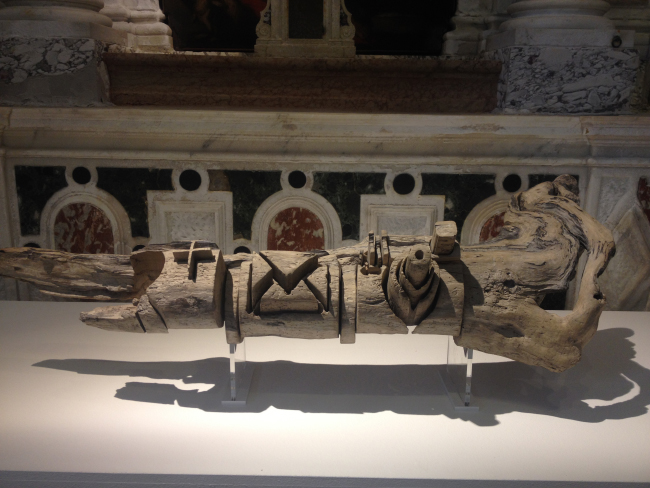
A view of Recycle Group. Conversion. Photo:
In place of an altarpiece, there are sculptures and mounds portraying these neo-apostles. Instead of rolled parchment containing holy writings, they hold in their hands modern-day electronic gadgets, and a huge “F” (the symbol for Facebook) has replaced the central cross. Also exhibited is an interpretation of the wreck of Noah's ark, with recognizable icons indicating smartphone apps. Every form and composition contains references to the iconography of traditional Christianity, but the materials used are decidedly modern, such as latex and polyethylene. www.mmoma.ru
- Jonas Mekas. The Internet Saga -
Spazio Ridotto (Calle del Ridotto - 1835 San Marco, Venezia)
&
Burger King (Palazzo Foscari Contarini, S.Croce 745/A, Venezia)
Through 22 November, 2015
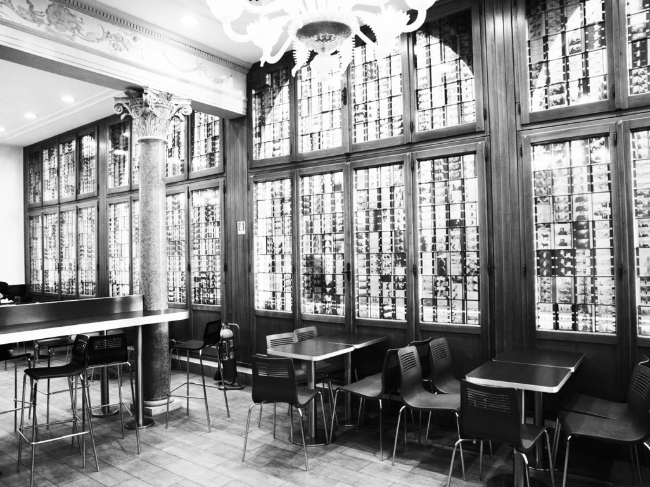
Jonas Mekas. In an Instant It All Comes Back to Me. 2015. Photo: Giacomo Cosua
This is a good way to expose people who have no intention of viewing art to a “bite-size” art experience. Up until autumn in Venice's only Burger King fast-food restaurant, along with your burger, fries and Coke, you can learn from your paper tray liner all about the American avant-garde film pioneer Jonas Mekas.
In place of the usual MTV music videos, the restaurant's plasma TVs show video works from Mekas' web-diaries, a project he's been working on since 2006. The restaurant itself has been transformed by way of vinyl window decals featuring Mekas' photographs, creating a distinct stained-glass effect. And lastly, in the Burger King's courtyard, loudspeakers play a 70-minute track featuring the sounds New York City and the eulogies that were read at Andy Warhol's funeral.
Among other things, The Internet Saga is the only project at the Venice Biennale dedicated to digital culture; at its center is art on the internet, and the study of the development of audiovisual language in the age of information technologies. Mekas' participation is unsurprising – having begun working via YouTube in 2005, he became one of the first web-stars of contemporary art.
As part of the same project, Mekas' works are also being presented in Spazio Ridotto and at www.internetsaga.com.
- The Union of Fire and Water -
Palazzo Barbaro (San Marco, 2840, Venezia)
Through 22 November, 2015

Rashad Alakbarov. Lion of Fuzuli (detail). 2015. Image: property of the artist and the YARAT Contemporary Art Centre
One of the most challenging exhibitions at this year's satellite program, in terms of sensory perception, is The Union of Fire and Water. It is Almagul Menlibayeva's and Rashad Alakbarov's view of the relationship between Venice and Baku throughout history. The location of the exhibition, in the Palazzo Barbaro, is significant in terms of its narrative context – in the 15th century Giosafat Barbaro, onetime owner of the Palazzo, extensively traveled throughout Azerbaijan, thereby becoming the first ambassador from Baku (Azerbaijan's largest city) to Venice.
A brick lion created by Alakbarov lies in the weak sunbeams entering the dusky inner courtyard of Palazzo Barbaro. Steep stone stairs lead into the just-as-shadowy rooms of the Gothic palazzo, the larger part of which have not been dressed-down as usual for exhibitions. In this case, the contemporary artworks fit into the natural grandeur of their surrounding environment in a truly interactive way.
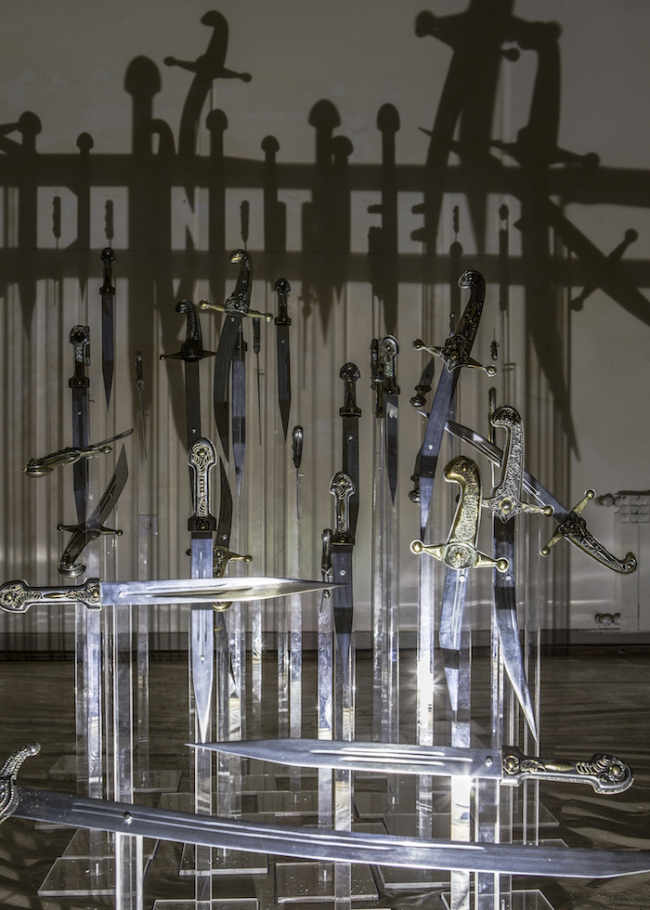
Rashads Alakbarov. Do Not Fear. 2015. Image: property of the artist and the YARAT Contemporary Art Centre
One of the most emotionally powerful pieces in the exhibition is Alakbarov's shadow artwork – this composition consisting of 99 traditional Eastern swords and a light source creates an epic phrase on the wall: Do Not Fear. Intriguing, but requiring both mental and physical effort is Alakbarov's installation Untitled (Omnes Viae Ducunt Venetias), a labyrinth of wooden staircases. Once this piece is conquered, one can continue on with the rest of the exhibition, which is sequentially accompanied from one room to the next by Menlibayeva's multi-channel video installation Fire Talks to Me. www.bakuvenice2015.com
- Frontiers Reimagined -
Museo di Palazzo Grimani (Ramo Grimani, Castello 4858, Venezia)
Through 22 November, 2015

Aaron Taylor Kuffner's kinetic sound installation. Photo:
The sounds of magical and mystical music literally lure pedestrians of the Castello district into the small inner courtyard of Palazzo Grimani. At the source of it all is a kinetic sound installation by artist and composer Aaron Taylor Kuffner, its concept based on gamelan – a genre of traditional Indonesian ensemble music. This modern-day version of gamelan – or as Kuffner calls it, the “gamelatron” – is robotic in nature, and its orchestral bells and gongs lull the listener with its meditative sounds... in preparation for entering the richly decorated interior of the Palazzo Grimani to view the Frontiers Reimagined exhibition.
 Floor covering made of porcelain skulls. Nino Sarabutra. Photo: instagram.com/serenaaquaro
Floor covering made of porcelain skulls. Nino Sarabutra. Photo: instagram.com/serenaaquaro
In the palazzo, more than 40 artists from around the world demonstrate how cultural borders disappear through art. Highlights include Korean artist Kwang Young Chun's intallation series Aggregation, made from satinwood paper; a remarkable “rug” made from porcelain skulls, by Thai artist Nino Sarabutra; and American artist Robert Rauschenberg's metalic Giallo Call Clut (Neapolitan). www.frontiersreimagined.org
- Sean Scully: Land Sea -
Palazzo Falier (Palazzo Falier, San Marco, 2906, Venezia)
Līdz 22. novembrim, 2015

Sean Scully. Land Sea. Property of the artist, Fondazione Volume, and the Timothy Taylor Gallery. Photo: Claudio Abate
Due to a medical disorder, the Irish-born, American-based artist Sean Scully wet his bed until 20 years of age; he has also experienced the death of his son, and was told by his psychiatrist to sod off. Scully greatly admires the work of Malevich, and he believes the greatest advantage of abstract art is the fact that it cannot be censored – he himself wishes to paint in a globally comprehensible language. He produces bands and blocks of colors – perhaps flags, perhaps horizons or abstract landscapes (even though he hasn't used the color green for decades); or, perhaps they are motifs from the works of the Irish authors James Joyce or Samuel Beckett...
As part of the Biennale's satellite program, the Grand Canal's Palazzo Falier is host to completely new works by Scully, said to be inspired by Venice and its waters. www.fondazionevolume.com
- Dansaekhwa -
Palazzo Contarini-Polignac (Dorsoduro, 874 (Accademia), Venezia)
Through 15 August, 2015

A view of the Dansaekhwa exhibition. Photo: Fabrice Seixas / Kukje Gallery
Although North and South Korea find it impossible to get along in their geopolitical part of the globe, this is not the case in Venice. Dansaekhwa is yet another exhibition of the satellite program in which art nobly unites (the other is India's and Pakistan's co-production, My East is Your West). Presented here is the Korean art phenomenon of the 70s and 80s known as “dansaekhwa”, or one-color painting. Many may be tempted to liken this art form to the Western monochrome or minimalism schools of painting, but keep in mind that dansaekhwa has its own historical context, aesthetics and form of execution which has physical, spiritual and emotional aspects.
The works on display by the Korean artists have been created by a special canvas-activating technique which consists of various methods of covering the canvas with paint – such as applying paint on the reverse side of the canvas, soaking the canvas, cracking the soaked and dried canvas, and peeling or scraping off the paint, and so on. Truth be told, this is one exhibition where it's worth listening to the guided tour.
Along with the works of six masters of dansaekhwa – Chung Chang-Sup, Chung Sang-Hwa, Ha Chong-Hyun, KIM Whanki, Kwon Young-Woo and Park Seo-Bo – also featured on the first floor of the iconic Palazzo Contarini-Polignac are site-specific compositions made of steel plates and natural stone, created by the well-known Korean painter, sculptor and philosopher Lee Ufan. www.villaempain.com
- My East is Your West -
Palazzo Benzon (San Marco, Calle Benzon, 3927, 30124 Venezia)
Through 1 October, 2015

Shilpa Gupta. A view of the exhibition My East is Your West. Photo: GQ India
For the first time in the history of the Venice Biennale, the two historically conflicting nations of India and Pakistan are presenting a united exhibition. The exhibition is the fruit of the cooperative labors of two internationally renown artists – Shilpa Gupta from India, and Rashid Rana from Pakistan. Both artists grew up in an atmosphere of spiteful conflict, and in their exhibition they reflect on how things would have been had the two nations not split up.
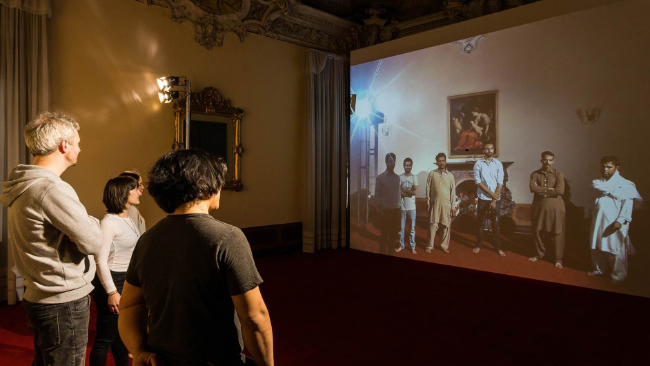
Rashid Rana. A view from the exhibition My East is Your West. Photo: GQ India
An interesting feature of the exhibition is the presence of regular people from both countries. For instance, in Rana's live-feed video work, viewers of the exhibition in Venice can converse with people in Lahor, Pakistan. In another room, Gupta has positioned an impressive amount of cloth upon which, day after day, a person uses carbon paper to draw lines that never intersect. The total length of the cloth is 3359.59 meters, which symbolizes the 3359.59-km-long border lined in barbed wire between India and Bangladesh; blue carbon paper is, of course, used to sign international treaties. www.gujralfoundation.org
- 001 Inverso Mundus. AES+F -
Magazzino del Sale n.5 (Dorsoduro, 262, (Fondamenta Zattere Ai Saloni), Venezia)
Through 22 November, 2015
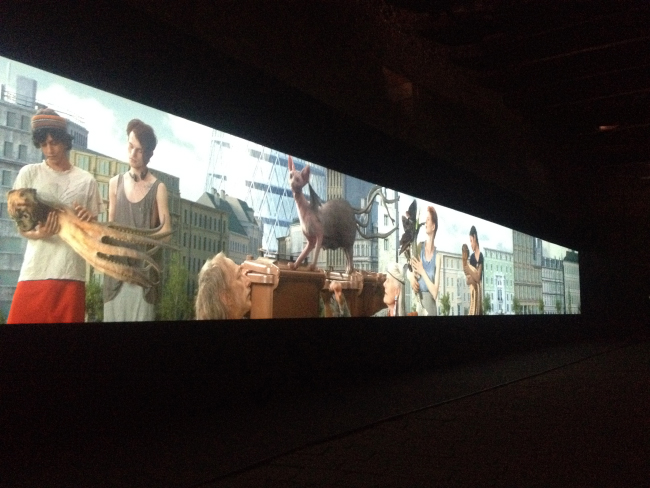
The Inverso Mundus video installation. Photo:
In the dark and cool space of Magazzino del Sale, viewers sit as if hypnotized. Perhaps this is because in the marathon of exhibitions that is the Venice Biennale, video works are the only legitimate means that one can employ to sit down and rest one's feet. But really, the absurdity and utopia imagined by the multi-channel HD video installation Inverso Mundus, or “Reverse Worlds”, is truly enthralling.
It is the AES+F artist group's interpretation of 16th-century utopian engravings. Their version shows scenes such as streets being cleaned with something that looks like sewage; beggars giving hand-outs to the rich; a pig butchering a butcher; a person carrying a donkey; and flying two-headed sea lions and mutant animals that have a dog's head, an octopus's body, and the wings of a house-fly. aesf-group.com
- Grisha Bruskin. Alefbet -
Fondazione Querini Stampalia (Castello 5252, 30122 Venezia)
Through 13 September, 2015
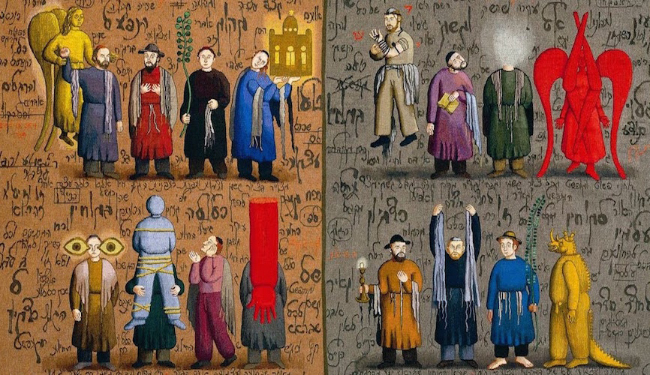
Alefbet. 2004 – 2006. ARAZZO
Up until the middle of September, the cultural foundation Fondazione Querini Stampalia is showing the works of Russian artist Grisha Bruskin. Bruskin's career experienced a turning point in 1988 when the film director Miloš Forman bought his painting The Fundamental Lexicon. Part One. At the time, the soviet authorities valued the piece at two thousand rubles. An absurdly low price, but the main thing here was the name of the purchaser. A few months later, these two thousand became 416,000 dollars in the first (and currently, only) Sotheby's auction to be held in Moscow featuring art of the Russian avant-garde and soviet era.
Buskin has created a structured framework of his own art world, one in which he systematizes signs, symbols and myths. Visually, this manifests as series of canvases and drawings in which the space is divided into columns containing various figures, groups or allegorical objects. In his first exhibition in Venice, Buskin has chosen to show five tapestries depicting his take on one of his favorite subjects – the system of Jewish characters. www.querinistampalia.org
- Jaume Plensa. Together -
Basilica San Giorgio Maggiore (Isola di San Giorgio Maggiore, 30133 Venezia)
Through 22 November, 2015
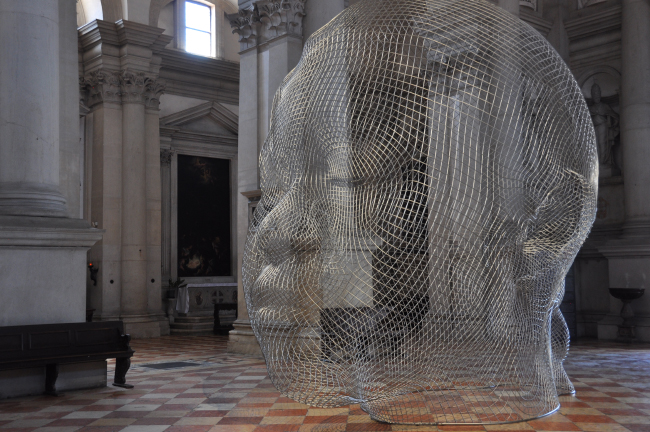
Jaume Plensa. A view of the exhibition Together. Photo:
The installation by Catalan artist Jaume Plensa in the Church of San Giorgio Maggiore (built by Renaissance genius Andrea Palladio in the 15th century) is one of the most spiritual and meditative art projects of the Venice Biennale. Called Together, it is made up of two figures. One is a head made from stainless steel wire mesh, hung from the ceiling like openwork netting. Depending on where one is standing and at what angle, the image of the head optically changes it shape and form, giving the piece an additional aura of mysticism. The symmetrical lines of Palladio's architecture “enter” the head through the netting, thereby literally becoming a part of the head. One sees, at the same time, both the inside and the outside of the body – both the physical form made of matter and the metaphysical self. Across from the head, also hanging from the church's ceiling, is the second sculpture, this one made of die-cast letters from eight world languages, arranged in the shape of a priest's hand giving holy benediction to his congregation.
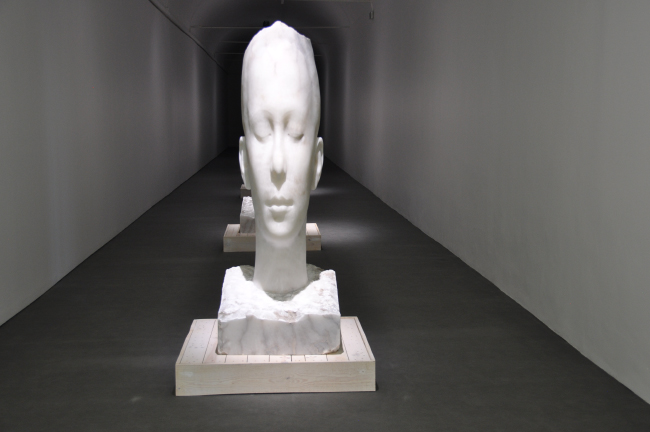

Jaume Plensa. A view of the exhibition Together. Photo:
In a different building not far from the church, another of Plensa's magical works is on display – five alabaster heads alined in a perspective line. Situated in a dark room, the seemingly stretched-out, blindingly white heads with closed eyes look something like a surreal hologram. It is a meditation on dreams. www.jaumeplensa.com
- Magdalena Abakanowicz: Crowd and Individual -
Fondazione Giorgio Cini (Isola di San Giorgio Maggiore, 30133 Venezia)
Through 2 August, 2015
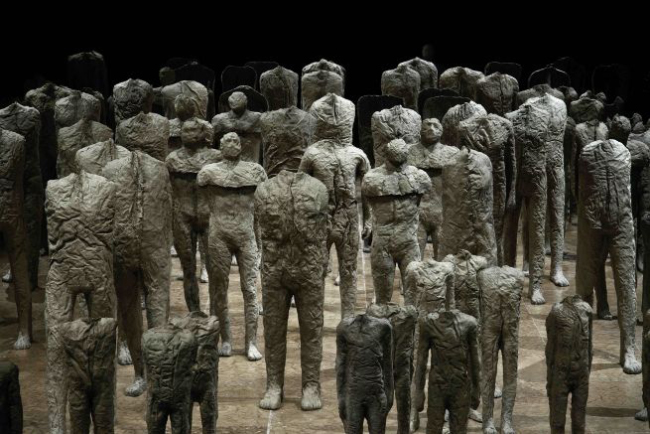
Magdalena Abakanowicz. Crowd and Individual. © Fondazione Giorgio Cini
In a Venice that is currently over-saturated and overflowing with art, Polish artist Magdalena Abakanovicz's (1930) large-format installation – or more precisely, a multi-figured sculptural artwork – is one of the most emotional and visually inspirational experiences one can have.
In the dark space, two separate areas – both in unmistakable conflict with one another – are illuminated. One consists of 110 human figures, some standing, some marching; some with heads, some headless. The other area features a strange, lone animal – a mutant; and a palpable atmospheric tension that is also mournful, in a way. Abakanovicz's form of expression – sculpture made from fabric and textiles – is her signature mark in today's art world; her innovative contribution to sculpture has been valued for several decades now. The figures' rough, imperfect surfaces and their life-size scale make them weirdly realistic; upon first view, they evoke an illusory balance between the real world and the unreal.
The relationship between the individual and a crowd has always been an element in Abakanovicz's 50+-year career. She actually has a whole series based on this subject, and she has traveled with it to exhibitions around the globe – including to the Venice Art Biennale in 1980, when she represented Poland, and again in 1996, when she exhibited her piece Crowd I in what was the Italian pavilion at the time.
- Proportio -
Palazzo Fortuny (S. Marco, 3780)
Through 22 November, 2015
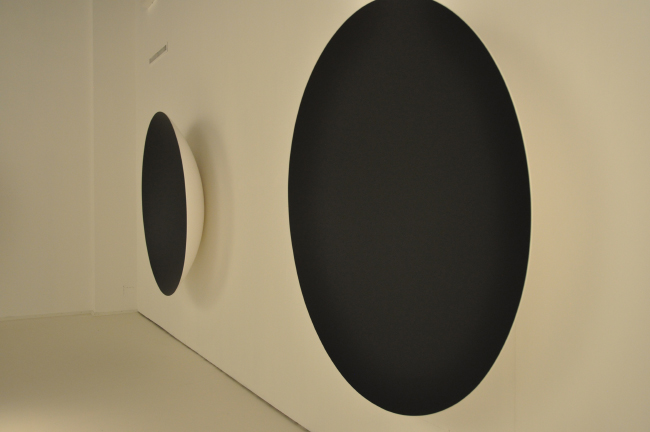
A view of the exhibition Proportio. Photo:
One of the most intriguing satellite events of the Biennale is the exhibition Proportio, as curated by Axel Vervoordt, art collector and dealer in antiques/art. It is housed in the Gothic Palazzo Fortuny, which was originally built for he Pesaro Family and then later acquired by the Spanish fashion designer and scenographer Mariano Fortuny (1871-1949), who set up his studio there. An especially notable invention of Fortuny's is the iconic Fortuny Moda Lamp – it caused a “revolution in lighting” in terms of both theater scenography and photography, where it still in use today. Fortuny was also a passionate art collector, and arranged his eclectic, multi-period art and artifact collection throughout the palazzo. After his death, his wife gifted the palazzo and its contents to the city of Venice; today it is open to the public only during exhibitions. The exhibition curated by Vervoordt is a story of proportions – in art, music, architecture and nature – and their meaning in the world that we inhabit today. It is about the unrelenting duel between order and chaos. Along with works by the Old Masters and 20th-century masterpieces, also on view are architectural models and contemporary art pieces. One whole room has been devoted to the Indian-British artist Anish Kapoor and his multi-sensory installation made up of spherical planes that literally pull the viewer in like a black hole, leaving one at a complete loss in terms of sense of time and space.
Also included in the exhibition are artists such as Marina Abramović, Antony Gormley, Albert Giacometti, Sol LeWitt, Le Corbusier, and Mario Merz, among others.
- Mario Merz. Città Irreale – Unreal City -
Gallerie dell'Accademia (Dorsoduro, Campo della Carita 1050, Venezia)
8 May – 20 September, 2015

Mario Merz. Luoghi senza strada. 1994. BSI Art Collection, Switzerland. © Mario Merz, by SIAE 2015
Italian artist Mario Merz is one of the most notable representatives of the Arte Povera art movement that took place in the 1960s and 70s. The exhibition Città Irreale – Unreal City reveals Merz's studies of space – the individual's personal space, public and urban spaces, and even outer space. As it is arranged in a chronological order, the viewer can follow the development of Merz's poetic vision – starting with his first studies of objects and architecture to his large-scale environmental installations. Of note is the fact that this exhibition also serves as the grand opening of the new exhibition rooms of the Gallerie dell'Accademia. www.gallerieaccademia.org
- Cy Twombly. Paradise -
Galleria Internazionale d'Arte Moderna – Ca' Pesaro
(Santa Croce, 2076, 30135 Venezia)
Through 13 September, 2015
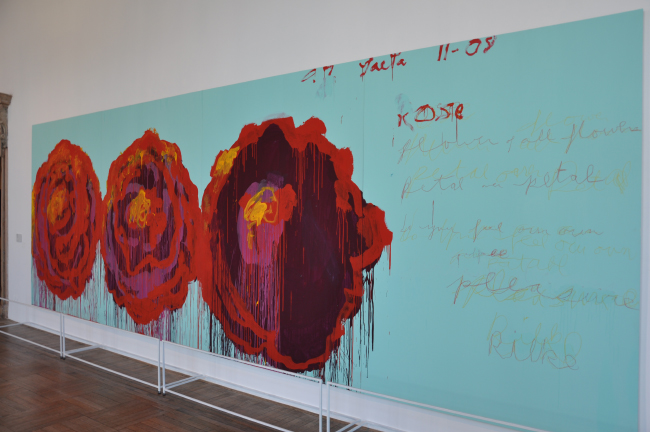
Cy Twombly. A view of the exhibition Paradise. Photo:
Abstract expressionism legend Cy Twombly (1928-2011) has been deemed one of the greatest American painters of all time, regardless of the fact that he spent the greater part of his life in Italy – having gone on a trip to Italy at the age of 28, he never went back. As Twombly himself said, his art lacked the heroics necessary to be understood in America. Twombly was a refined and dapper sort – both in life and his art – they indisputably exude an energy that the viewer can also absorb just from looking at them. The exhibition “Cy Twombly. Paradise” is a journey through six decades of the artist's creative career in which he worked intensively with both painting and sculpture. In his signature manner, Twombly combined painting with poetry, and sculpture with words. Included in the exhibition are Twombly's legendary “Roses” – inspired by Rilke's poem “Le Roses” to the point of even featuring whole stanzas of Rilke's text. Twombly's roses are in the height of bloom, the purple of their petals bleeding into saturated reds, burgundy and gold. Painted on a turquoise background, the paint drips from the succulent blooms, thereby reminding the viewer of life's gravity and ultimate mortality. The show contains 60 of Twombly's works, including the very last ones created shortly before his death, when he was already affected by physical disability. capesaro.visitmuve.it
- The Bridges of Graffiti -
Arterminal, Terminal San Basilio (Fondamenta Zattere Ponte di Legno, Dorsoduro)
Through 22 November, 2015

The artist at work. © 2015 Mode2
This year the passenger cruise terminal of San Basilio has become home to an art form untypical for both Venice and the Biennale, namely, graffiti. The concept of the exhibition is to act as a bridge connecting two different nations and cultures: a link between Venice and the largely black-populated neighborhoods of New York City; a link between the street art of New York and the “elitist” art of the Venice Biennale. In The Bridges of Grafitti, ten (well-known in the Italian art community) virtuoso artists of markers and spray paint – Boris Tellegen, Doze Green, Eron, Futura, Mode2, SKKI ©, Jayone, Todd James, Teach and Zero-T – have combined forces. Alongside the graffiti images that were made on-site is a video installation featuring the most popular place for street art of all – subway trains – which are constantly zooming by. Also set up in the exhibition is a diorama of a bedroom inhabited by a passionate street artist, his walls entirely covered in graffiti sketches. www.bridgesofgraffiti.com